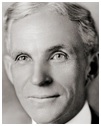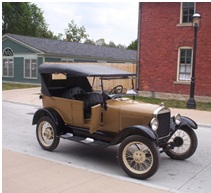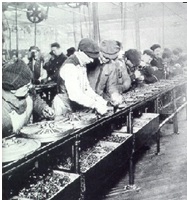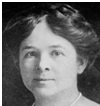|
 |
|
 |
Henry Ford Leadership
Henry Ford (1863-1947)
American founder of the Ford Motor Company in 1903 (pictured right), who made his famous Model T in 1908-27. Time magazine’s businessman of the twentieth century but hated Jews (inspiring Hitler), Roman Catholics and even
his son, Edsel. Why was he a great leader?
1. Vision “A car for the masses… one in every family”, was his future ideal, and this more than anything else changed the way people lived in the twentieth century. His emphasis on living in the present to create a better future led to his famous remark: “History is more or less bunk. It’s tradition”. 2. Revolutionary His Model T (pictured right) was the first cheap, mass-produced car for ordinary people. In 1913, at his Highland Park factory near Detroit, he built the Model T on the world’s first moving assembly line . Workers repetitively made different small parts of the moving car until it was finally finished at the end of the line. This made it much cheaper and quicker to produce (1½ hours instead of 12 previously). 3. Customer satisfaction The Model T’s success resulted from its:
He cut its price from $950 in 1908 to $290 in 1927, selling 15 ½ million of them in America alone. He didn’t give people any choice. “Any customer can have a car painted any colour that he wants so long as it is black”, he said. But in the late 1920’s he lost sales to his main competitors, General Motors and Chrysler, because they gave people more variety and style. But Ford also showed that it’s a mistake to slavishly follow customers when a revolutionary new product (like the Model T) is developed. “If I’d asked my customers what they wanted, they’d have said a faster horse”, he said.
4. Motivator Work on the assembly line was extremely boring and stressful, so he relied upon money to improve his workers’ performance and stop them leaving. In 1914 he increased their pay to $5 a day, twice the industry average, and had to fight people
off with fire hoses! But by the early 1930’s, he had become a brutal, anti-union employer and other companies’ wages had caught up. So his workers wanted to join a trade (or labour) union to get more money. He fought them with thugs and company police (including the Battle of the Overpass), and riots took
place. But he eventually agreed to the union after pressure from his wife, Clara (pictured right above, and son, Edsel (pictured right).
5. Lifelong learning Ford:
Ford rigorously checked:
But he learned bad things as well as good. He hated:
6. Teamwork He had great support from his wife, Clara, and his employees, particularly:
a) James Couzens - pictured right (Ford’s sales manager who established a network of agents to sell his cars ). b) Harold Wills - pictured right (who created Ford’s famous logo and, with Henry Ford, the revolutionary idea of fitting a car’s cylinders vertically instead of horizontally).
7. Determination and energy He was incredibly:
He also used his energy to help America during the Second World War, building thousands of bombers, jeeps and aeroplane engines in his huge River Rouge factory in Detroit.
8. Control He liked to have as much control as possible over his business. So he:
a) told people what to do (which annoyed them but speeded up decisions).
b) never borrowed (money for expansion came from profits).
c) bought his main sources of raw materials Coal and iron ore mines, forests (for timber) and glass works.
Key quote on change Progress is attitude
Key quote on the past. present and future History is more or less bunk. It’s tradition.
Key quotes on customers Any customer can have a car painted any colour that he wants so long as it is black It is the customer who pays the wages.
Key quote on influencing people You can't build a reputation on what you are going to do.
Key quote on objectives and vision I will democratize the automobile.
Key quote on market research If I‘d had asked my customers what they wanted, they’d have said a faster horse.
Key quote on quality Quality means doing it right when no one is looking.
Key quote on management Don’t find fault, find a remedy.
Key quote on government and politics Less government in business and more business in government.
Key quotes on success There is no disgrace in honest failure; there is disgrace in fearing to fail. Failure is only the opportunity to begin again, only more intelligently
Key quote on education An educated man...is one who can accomplish things.
Key quote on business success Make the best quality of goods possible at the lowest cost possible, paying the highest wages possible
|
|
|
||
|
|
|
||
|
||
| Copyright © wisdomtowin.com All Rights Reserved | ||
|









